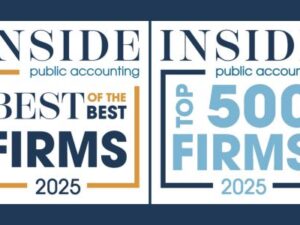How Small Businesses Can Deflate Their Inflation Risks
Aug 16, 2022

From soaring gas and food prices to hikes in rent, the signs of inflation are popping up everywhere.
The latest Consumer Price Index Report (CPI) showed that between June 2021 and 2022, inflation rose 9.1%, the highest incline the U.S. has seen since 1981.
In fact, inflation is the number one concern for small business owners. According to the March Chamber of Commerce survey, 67% of small businesses have raised prices, and approximately 40% have decreased staff in the past year due to inflation pressures.
While the figures may feel dizzying, it’s important for business owners to take a step back and separate facts from fears.
While few business owners are happy to hear of soaring prices on top of the ongoing supply chain and labor force disruptions, there are steps you can take to strengthen and shield your business against the effects of inflation.
How Did We Get Here?
With inflation reaching a nearly 40-year high, everyone is wondering how we got here. A perfect storm of factors over the past three years gets much of the blame, with some arguing that pandemic relief, including stimulus checks and an increased child tax credit, injected more money and demand for goods and services into a supply chain that couldn’t keep up.
Some have argued that price gouging has also played a role. Under this theory, also known as “greedflation,” inflation is being exacerbated by companies blaming inflation and the war in Ukraine to push price hikes that aren’t fully justified.
Labor costs have also spiked since the pandemic, both as a result of shortages and a surge in workers quitting their jobs to focus on a better quality of life – or at least better paying jobs.
The lack of affordable childcare – an ongoing crisis thrown into relief during the pandemic – has also kept many parents out of the workforce.
Inflation & Interest Rates
Whatever the reasons, it’s a lot for any small business owner to navigate.
Interest rates are being raised in an effort to slow inflation. The Federal Reserve raised its rate by .75 percentage points for the second consecutive time July 27, bringing its target rate to a range of 2.25 to 2.5% and further bumps can be expected.
It’s important to keep in mind that interest rate increases will not just impact new loans, but those with variable interest rates too. That means you may want to get financing as soon as possible, especially if you’re seeking funds with a fixed rate.. That said, keep the cost of borrowing in mind along with the long-term cost of carrying credit card balances.
How Small Business Owners Can Combat Inflation
It may feel as if hiking prices is your only good option, but you have other tools you can turn to, beginning with close scrutiny of your costs. Here are five strategies for biting back.
1. Elevate Your Spending Visibility
Make sure you have visibility into your spending across categories, departments, processes, and business units, so each of these sectors of your business is accountable for their performance and understands its larger impact to the company’s overall P&L. If any department or location isn’t bringing home the necessary bacon, it may be time to close it down.
2. Cut Costs with a Long-Term Strategy in Mind
Choose what costs to cut wisely. Make sure that your efforts to save money are supported by the long-term strategies of your company.
For example:
- Don’t cut benefits that may cause employees to leave; the cost to hire is expensive
- Examine where you can more selectively trim costs to improve the return on operating expenses
- Boost growth through greater investment in strategic capabilities; one way of doing that is using an employment strategy that can differentiate yourself in labor competition
3. Identify what Drives your Spending & Make Changes
When things are going well, it can be easy to develop or overlook poor spending habits. Now is the time to get them buttoned down. Scrutiny of your spending practices never fails to pay for itself. Here are a few ways to get started:
- Establish spending oversight and control measures
- Look for opportunities to make something you currently purchase
- Create a preferred vendor program
- Factor in variable interest rates
- Conduct a pricing analysis
- Cut back on extras
- Eliminate the use of high-interest credit cards
4. Reduce unnecessary work
You might be surprised by what a close review of your work processes may reveal. Wasted time can hide in unexamined habits. Do you know how your employees spend their time? One example of reducing unnecessary work is hotels who ask their guests if they want daily cleaning services (many don’t).
What can you automate? You may not be able to automate a service team but a scheduler that integrates with your customer management system could save you quite a bit of money and allow your team to schedule their own hours. Everyone wins.
Inventory management is another solid contender for automation. Manual inventory is never going to be as efficient or as accurate as a system that can read a barcode and input data accordingly. Time savings can be leveraged for even bigger gains, creating the time to analyze data, optimize your company’s workflows, engage in strategic activities, and elevate your bottom line.
And last, but definitely not least, accounting software can not only save you time but also quite a bit of money in clerical errors and eventual audits.
Let go of the Excel sheets and opt for accounting software like QuickBooks to help with your bookkeeping. Programs like DEXT or Bill.com can help you reduce administrative time, as well as keep billing in order and in communication with your accounting software.
5. Work with an Accounting Partner who Understands Your Business
Small business owners have an unprecedented journey before them in today’s political and post-pandemic climate. A little prudence can help steel your enterprise for whatever lies ahead. The right accounting partner is one who takes the time to know your business and help you identify the clearest path to your goals, in any economy.
Contact us to learn more about accounting and advisory services
Sign Up for Email Updates
Accounting & Financial News

Practical Examples of QSB Gain Exclusion Post-OBBBA
Qualified small business (QSB) stock offers valuable tax-saving opportunities, especially with the enhanced gain exclusion limits under…





